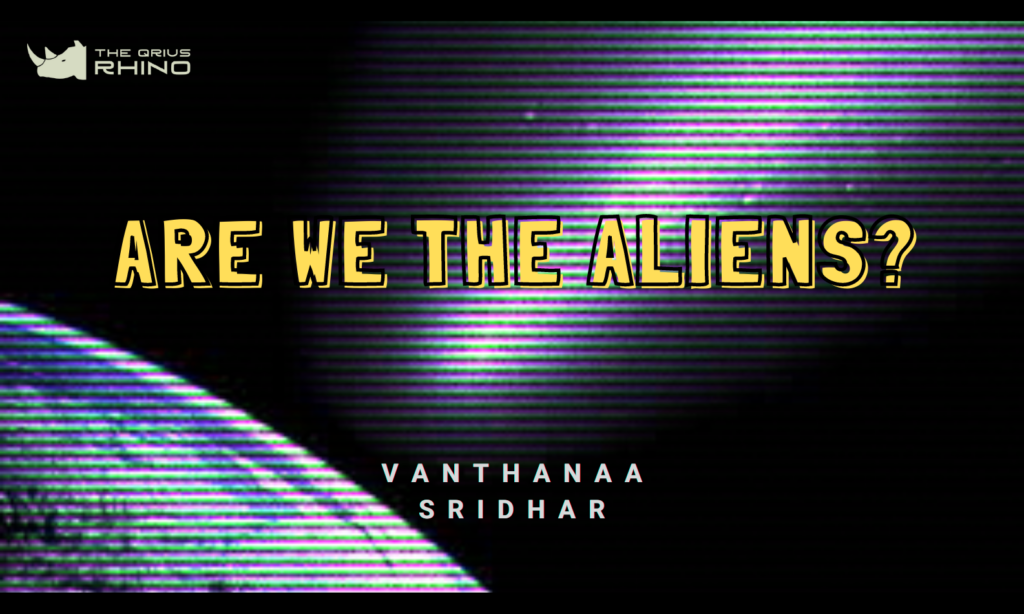
Panspermia is the theory that states that life was transferred to our planet from elsewhere. And the term “elsewhere” could mean anything. It might not even be from our solar system, and it might not even be from a planet for all we know. And if this theory is true, it would mean that we aren’t earthly beings, or, in other words: we didn’t evolve from earthly life.
This theory came about when greek philosopher Anaxagoras put across the idea that “seeds of life” exist everywhere in the universe and that they travel across various planets. He coined the term panspermia with its literal meaning being “all seed” (“pan” means all, “sperma” means seed)
In the 19th century, Swedish scientist, Arrhenius, stated that microscopic spores travel through space. He said that the sun’s rays (which basically contain photons) push these seeds through space by transferring their momentum to them, giving them a velocity boost. This velocity boost results in something called solar radiation pressure. However, the momentum transferred is extremely small. This momentum transfer or boost in velocity is only observed in very big, light, and slow-moving entities (such as a meteor, we’ll talk about this later).
It’s quite obvious that if life was transferred to Earth, the first question that we would ask is: Where and how did that life originate?
And of course, we can’t help but wonder: How did it survive interplanetary/interstellar travel? How long did its travel take?
PANSPERMIA RESEARCH
Since we don’t have time machines (yet :P), scientists are trying to see if the currently known photosynthetic bacteria, cyanobacteria and other archaea can survive in outer space (obviously, it doesn’t match with the actual photosynthetic bacteria that existed at the dawn of life and has mutated and undergone adaptation exponentially since). The bright side is that it doesn’t really involve significant assumptions like the Urey and Miller experiment* because space hasn’t changed since the beginning of time. It has the same standard conditions:
- Microgravity
- Vacuum
- high radiation exposure
- extreme temperatures, etc.
Urey and Miller experiment* : performed to show that life could’ve originated naturally on Earth owing to suitable atmospheric conditions and water as a universal solvent (Further read: https://www.simsoup.info/Origin_Landmarks_Miller_Urey.html).
CAN MICROBES SURVIVE INTERPLANETARY TRAVEL?
About 10 years ago, the European Space Agency (ESA) conducted an experiment where they exposed a microbial community containing species of cyanobacteria, algae and bacteria to outer space conditions for 548 days by launching it into low earth orbit. They found that some of the species survived the harsh space conditions.
A group of Japanese scientists recently experimented with Deinococcus radiodurans by exposing them to space conditions for about three years, and the species survived the radiation and cell damage. They placed dried cell pellets of the bacteria on aluminium plates attached to the International Space Station walls.
Both these experiments are highly fundamental in panspermia research, as if these species can survive in outer space, they might even be eligible for long term interplanetary travel. Although there are many estimates, we still do not know the maximum amount of time for which a microbe can survive in outer space.
EVIDENCE FOR THE OCCURRENCE OF PANSPERMIA?
Meteor landings are the most probable way of transferring life naturally. In all three aspects of life transfer, i.e. launch, interplanetary travel and atmospheric entry and landing, meteors seem to tick the boxes. They are also impacted by solar pressure radiation (as discussed earlier). Microbes use meteors as a platform to attach themselves to, and usually, they settle in the core of these rocks to seek maximum protection during travel and landing.
The most notable one is ALH84001, a Martian meteorite discovered 13,000 years after landing on Antarctica. There were claims that the surface of this meteorite had long tubular structures resembling microbes. Moreover, the meteor also contained chains of magnetite and some polyaromatic hydrocarbons, which some bacteria can produce. When individually looked at, these compounds seem to point towards standard chemistry, but when looked at together hint towards biology. Scientists do not accept this theory widely yet, as the debris found could be several million years old since its takeoff from Mars. Hence, the data isn’t as conclusive as we’d like it to be. But it does give us some lead.
Particles freely moving in the upper atmosphere were collected in the 1960s and studied by EK Brigg. It resembled bacteria and large viruses. Fred Hoyle also stated that balloon flights sent up into the stratosphere in the US in 1960 managed to collect living bacteria from there. The only question is: what are they doing there?
There must be a reason.
Microbial spores alive for 100 million years beneath the seafloor of the South Pacific Gyre were recently discovered, implying that microbes could survive for extremely long periods in extreme conditions with significantly less food available during sporulation.
WHERE DID ‘THAT’ LIFE ORIGINATE FROM? CAN WE FIND IT?
We do not know if the exobody from which life got transferred still contains life. Civilisations keep forming and dying. So we must not only look for life that is alive, but also the life that is dead; debris.
This can be tricky because it depends on when that life ceased to exist. If it were, say, a billion years ago, our current equipment wouldn’t be sensitive enough to capture it. Moreover, identifying and locating the planet from where life transferred is another issue. Where do we start looking? We can begin collecting samples from places within our reach, like the moon and mars, but we don’t know if the transferred life came from Mars or the moon. If it did, then I’d say we’re super lucky.
We can do comparative sample testing and see if the compounds (what we assume to be cell debris) match what we see on Earth. But that’s the issue with life; Chemistry can also generate many things generated by Biology. How do we know what is what?
Another issue is that we do not know what kind of life thrived there or the compounds it produced or formed to look for biosignatures. Technically, we wouldn’t know what to look for.
This brings us to the next question. Do we really need to find the planet from where life got transferred? Or at least, do we need to find it right now?
This is where I think panspermia enthusiasts and scientists must define their aim. In my opinion, our aim, for now, is to show that “Panspermia could’ve happened” by using microbes available on Earth and testing their travel in space.
Hopefully, with future developments in our technology, long-distance space travel and necessary funding, we can venture into this crazy search expedition!
WHAT COULD THIS MEAN FOR THE FUTURE?
I had a couple of interesting thoughts. If something transferred the very first primate organism to the Earth from another planet, then it would mean that two planets can share the same building blocks of life. This could mean that aliens (if they are out there) are probably like what we see on Earth.
OR
What if the first organism that transferred to Earth was NOTHING like present ‘earth like’ life? Could it have evolved to such an exponential extent that it turned itself into a completely new form of life and became what we see now on Earth? A few scientists created an enzyme whose building block is XNA (Xeno nucleophilic acid), which is basically like DNA or RNA but has a different sugar molecule attached. Think about it! Can’t a few million years cause a change in the sugar molecule of a nucleic acid? Or, can the structure of the nucleic acid and its function change?
If we somehow understand this process, imagine being able to engineer alien life! Or, basically, any form of life! It would help broaden our search for extraterrestrial (ET) life beyond DNA/RNA based life.
CONCLUSION:
Since we are only at the very early stages of astrobiology studies, we must be as crazy and creative as possible. It is essential to keep in mind that just because this theory puts across many questions doesn’t mean that it isn’t valid. No one knows how life originated. It could’ve naturally evolved on Earth, or it could’ve not, or maybe it was a mix of two, and the Earth just got lucky with the timing. Or perhaps it was just complex organic compounds transferred to Earth (Pseudo-panspermia) that enhanced the process. So the only thing we can do is put our current scientific knowledge to use, club it with our ability to be creative and be open to all possibilities.
By Vanthanaa Sridhar (B.Tech in Biotechnology student, SASTRA University)
References:
- 2011 ESA EXPERIMENT: https://www.ncbi.nlm.nih.gov/pmc/articles/PMC3176519/
- EXPOSING Deinococcus radiodurans TO SPACE BY JAPANESE: https://www.frontiersin.org/articles/10.3389/fmicb.2020.02050/full
- ALH 84001: https://www.lpi.usra.edu/lpi/meteorites/The_Meteorite.shtml
- UPPER ATMOSPHERE CONTAINING MICROBES POSSIBLY: https://www.panspermia.org/cantest.htm
- SPORES UNDER SEA BED: https://www.sciencemag.org/news/2020/07/scientists-pull-living-microbes-100-million-years-beneath-sea
- XNA BASED ENZYME: https://www.newscientist.com/article/dn26641-synthetic-enzymes-hint-at-life-without-dna-or-rna/
- HISTORY OF PANSPERMIA: https://ui.adsabs.harvard.edu/abs/2019asbi.book..419K/abstract
About the author:

Hi! My name is Vanthanaa and I am currently pursuing B.Tech in Biotechnology at SASTRA University. I am probably the weirdest and most talkative person I’ve ever met. Here’s a bit of philosophy: I like to believe that scientists are like artists. Instead of beautiful paintings, we make better lives.
This is Vanthanaa’s first blog on TQR.
A very intriguing thought! Would love to see more posts like this.